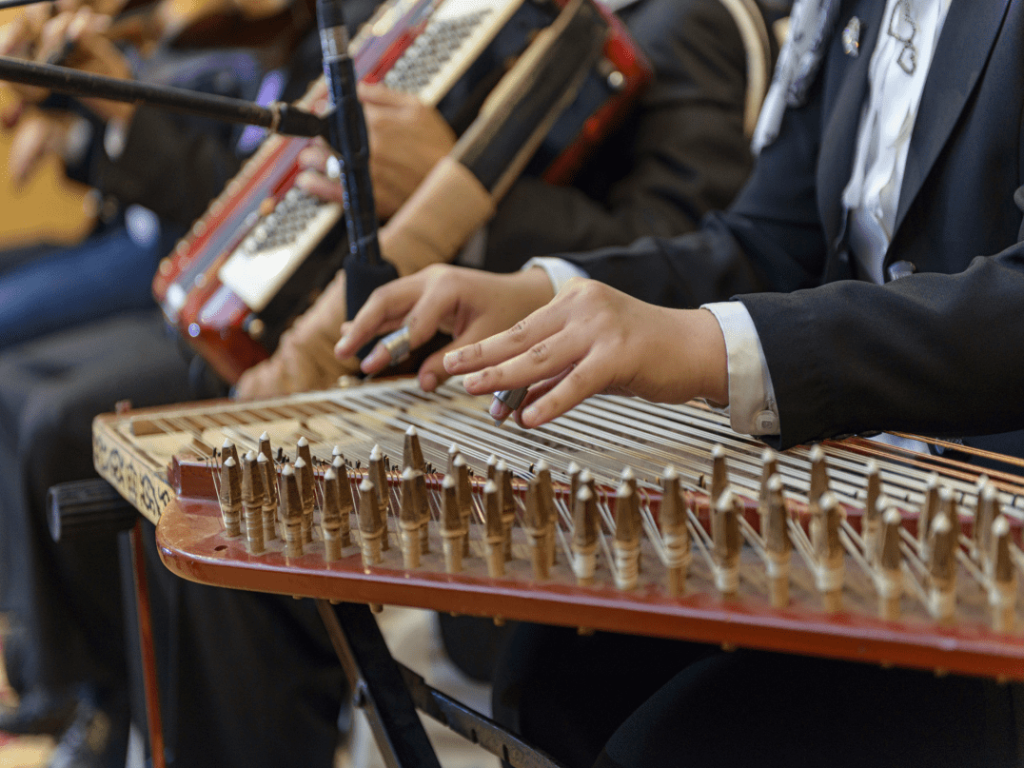In the first part of our article on Arabic music and Arab instruments, we briefly discussed Arabic musical history. In the second part of the article, we will continue our talk. However, we will discuss the Arabic music instruments that give Arab music such a unique sound.
Nearly 100 years after the death Abu Yusuf Ya’qub ibn Ishaq Al–Kindi in 874 A.D., another Arab philosopher, Abu Nasr Al–Farabi wrote a book. The Alkitab Alkabeer (or “The Great Book”) included immense and detailed information on music and musical instruments.
The contributions of Al-Farabi
A good mathematician and physicist, Al-Farabi was able to do justice to what the Arabs called speculative theory. More than anything else, however, Al-Farabi was also one of the few practical Arab musicians who appreciated the art of music as well at its theories which Greek philosophers like Themistius could not do. So, as a well reputed musician, Al-Farabi could bring the practical art to fruition in his discussions. In fact, he even went a step further, making valuable contributions to physiological acoustics. In other words, the sensations of tone, something the Greeks never even scratched the surface in accomplishing.
One example of acoustics is in an Arab musical instrument that Al-Farabi called Al-Tunboor Al-Baghdadi. The instrument’s dasateen, a Persian word for the frets of the instrument, gave a quarter-tone pre-Islamic scale which was created by dividing a string into forty equal parts.
Indeed, Arab culture had an impact on the rest of the world in regards to musical instruments. You can see this in the Arabic origin of English words for instruments like lute (al-‘ud), rebec (rabab), guitar (qithara) and naker (naqqara). Other Arabic words for instruments like ad-duff, al-booq, an-nafeer, al-shabbabe, at-tabl and at-tinbal have morphed into the English versions of instruments known as adufe, albogon, anafil, exabeba, atabal, and atambal, respectively.
The adufe
The ad-duff is a pine wood traditional square tambourine, with a goat’s skin mounted over.
The albogon
The albogon resembles the Arabian al-booq. The Andalusian Sultan Al-Hakim II improved this type of horn in the third century. It is an ancestor of the modern-day saxophone.
The anafil
While we’re on the horned instruments, there is the Arab an-nafeer (anafil in English), a long straight trumpet. People say that this is the instrument that the trumpeter “blasted” in Alf Laila wa Laila (A Thousand and One Nights). On the other hand, the horn player “blew” could be referencing the albogon (al-booq). Perhaps the words “blew” and “blasted” are used to differentiate the tones of the conical bore horn (albogon /al-booq) from the cylindrical bore trumpet (anafil/an-nafeer), respectively.
The atabal and the atambal
The atabal (at-tabl, or dirbakka/dirbakki in the Levantine dialect of Syria, Lebanon, Jordan and Palestine) is a big drum. Atambal (at-tinbal) is also a big drum, but one that primarily military use in parades and processional music. Western armies adopted the atambal for their military bands during the Crusades. In fact, the entire drum family (including drumsticks) came into Western Europe through the Arabian contact as they used them with the maqam as far back as the 12th century Abbasid era when Baghdad became the capital of the Muslim World.
The kaithaar
Among stringed instruments is the kaithaar, precursor to the flat-chested guitar in Europe. The Spanish word for guitarra (and thus the English “guitar”) came from the Arabic qitara. Additionally, it appears that the Arabic words qitara or qithara were only used when talking about the Greek or Byzantine instruments. Meanwhile, Arabic instrument was strictly called the kaithaar.
The kanon
The qanun (sometimes “kanon”, “canon”, or “canale” in Europe) is a trapezoid instrument with 64 to 82 strings. It is played by plucking the strings with plectrums attached to the index fingers. A similar instrument is the al-santoor; however, it is played with two sticks instead of the two plectrums attached to the index finger.
The oud
Our next stringed instrument is perhaps the most well-known of Arabic musical instruments know as the oud (al-‘ud). The oud is a half-pear shaped instrument with 10 to 12 strings and 40 frets.
The al-jawz and the rababeh
Two other stringed instruments you’ll hear used in traditional Arabic music are the al-jawz and the rababeh. The al jawz takes the name from it’s material, jawz al-hind, or the “coconut”. Today, it is primarily played only in the Arab instrumental music of Iraq. The rababeh, on the other hand, is a square, one stringed instrument played with a bow. First introduced by the Arabs in Spain, it soon spread all over Europe where it became known as the “rebec”.
The exabeba and the al-naay
Finally we have the woodwind instruments. This family of Arabic instruments have influenced music all over the world equal to that of the drum family. One such instrument is the small flute – the exabeba (al-shabbabe in Arabic). Another flute, this one vertical, is the al-naay. It is one of the oldest instruments in Arabic music. Sugar cane is the material for this instrument. The flautist will simply blow diagonally across the open end to play it.
Now that you know a little bit about Arabic music and the instruments, listen to some classical Arabic music and let us know what you think. We’d love to hear from you.
If you liked the second part of this article, and would like to learn more about Arab music or Arab culture in general, or if you would like to know how you can learn to speak Arabic, why not try our Arabic learning app? Researchers agree that Arabic learning apps are the best way to learn Arabic and Arabic dialects, and there’s no better app available to help you learn than the Kaleela Arabic learning app. Visit our website and find out how you can download the Kaleela Arabic learning app to your IOS or Android mobile device and start to learn Arabic language skills today.
Kaleela – Learn Arabic the Right Way!



